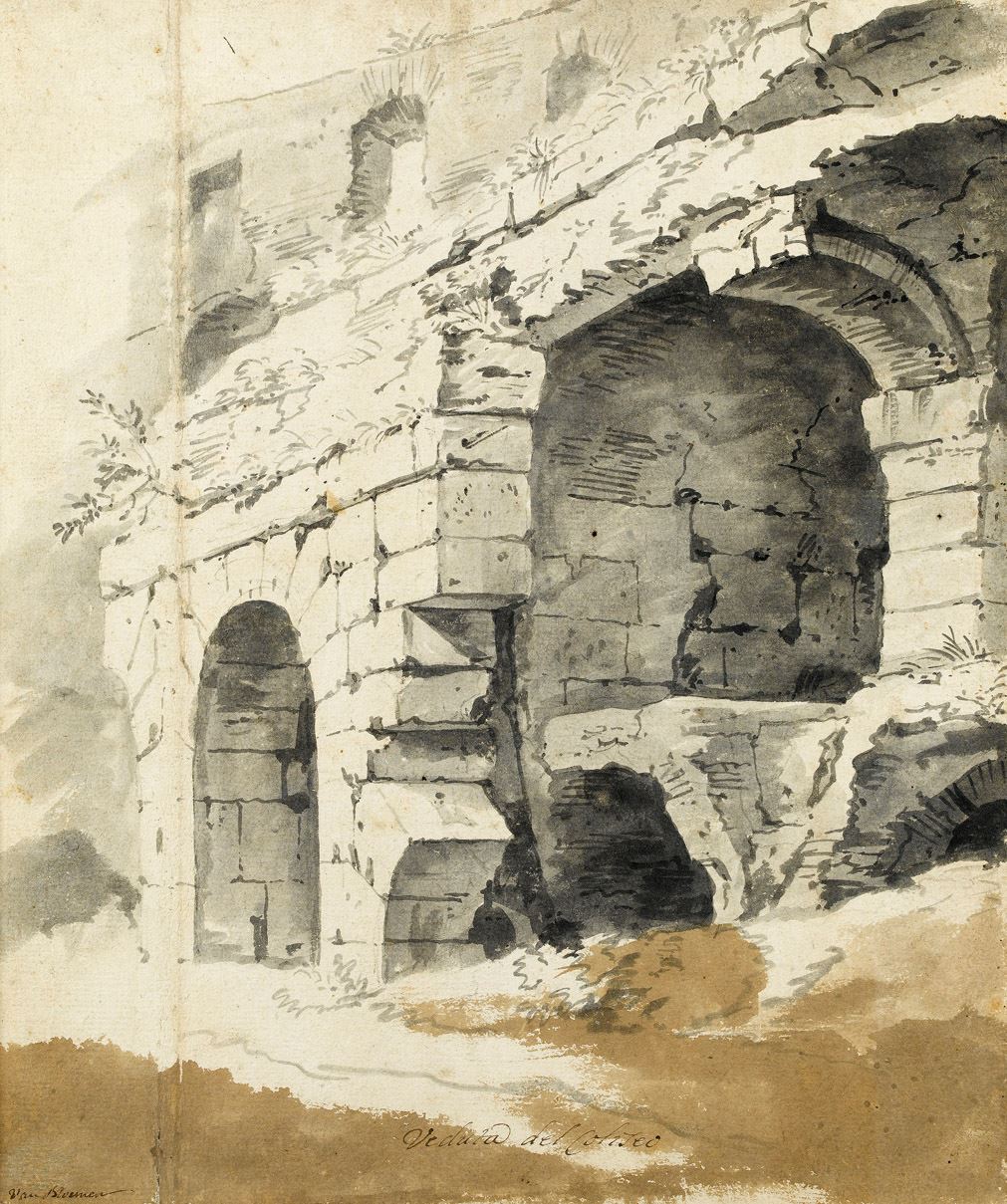Jan Frans VAN BLOEMEN
(Antwerp 1662 - Rome 1749)
The Walls of the Colosseum, Rome
Sold
Brush and grey and brown wash, with framing lines in brown ink.
Laid down on a 19th century French mount.
Signed(?) Van Bloemen at the lower left and inscribed Veduta del Coliseo at the lower centre of the sheet.
330 x 282 mm. (13 x 11 1/8 in.)
Laid down on a 19th century French mount.
Signed(?) Van Bloemen at the lower left and inscribed Veduta del Coliseo at the lower centre of the sheet.
330 x 282 mm. (13 x 11 1/8 in.)
The ruins of the Colosseum had long been a popular subject for Dutch and Flemish artists in Rome, and Van Bloemen produced a number of paintings and drawings, as well as an etching, of the site. Chief among these are a pair of small paintings of the interior of the ruined structure, now in a Roman private collection, which are thought to date from early in his stay in Rome. A preparatory study, in black chalk alone, for one of these paintings is in the collection of the Museo di Roma in the Palazzo Braschi in Rome. Stylistically comparable to the present sheet is a drawing of the ruins of a ruined amphitheatre – probably also the Colosseum – in the Devonshire collection at Chatsworth. Two further drawings of the interior of the Colosseum by Van Bloemen are in the National Gallery of Scotland in Edinburgh, while an etching by the artist of another view of the interior of the amphitheatre is also known.
The signature or inscription on this drawing is identical to that found on a view of the Campo Vaccino in Rome, one of five drawings by Jan Frans van Bloemen formerly in the Van Regteren Altena collection in Amsterdam. Two further drawings of Roman subjects in the Van Regteren Altena collection, one depicting the Arch of Gallienus and the other a relief on the Arch of Titus, may be compared stylistically with this drawing.
The signature or inscription on this drawing is identical to that found on a view of the Campo Vaccino in Rome, one of five drawings by Jan Frans van Bloemen formerly in the Van Regteren Altena collection in Amsterdam. Two further drawings of Roman subjects in the Van Regteren Altena collection, one depicting the Arch of Gallienus and the other a relief on the Arch of Titus, may be compared stylistically with this drawing.
A pupil of his older brother, the landscape and animal painter Pieter van Bloemen, Jan Frans van Bloemen completed his apprenticeship in the studio of Anton Goubau in Antwerp. Accompanied by his brother, Jan Frans arrived in Rome in 1686, and both artists were soon admitted into the Schildersbent, the association of Netherlandish artists in Rome. Van Bloemen was to remain in Italy until his death in 1749, earning the admiration of his contemporaries, some of whom are said to have regarded him as the equal of Claude Lorraine and Gaspard Dughet, by whom he was strongly influenced. He soon gained the nickname ‘Orrizonte’ (the Italian for ‘horizon’), in honour of the seemingly limitless vistas in his landscapes. Van Bloemen’s landscape paintings – occasionally enlivened with figures painted by artists such as Pompeo Batoni, Placido Costanzi or Carlo Maratta - proved very popular with aristocratic Roman collectors; Prince Camillo Pamphili commissioned a series of paintings from him in 1711, while the noble Colonna family apparently owned more than eighty pictures by the artist. He also sold many paintings to English noblemen visiting Rome on the Grand Tour. Despite his success, however, Van Bloemen was only admitted to the Accademia di San Luca in Rome in 1742, at the age of eighty.
The artist’s biographer, Lione Pascoli, makes several references to Van Bloemen having made many drawings of Rome and its surroundings. Nevertheless, by comparison with his paintings, relatively few drawings by the artist are known today. Like many Dutch and Flemish artists in Rome before him, Van Bloemen made drawings of buildings and ruins in and around the city. His use of a combination of pen, brush and ink with gray or brown washes, seen to such fine effect in the present sheet, is akin to drawings of the same views produced by some of his Netherlandish predecessors in Rome, such as Cornelis van Poelenburgh and Bartholomeus Breenbergh.




